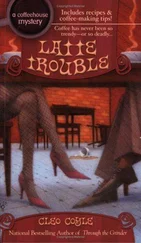“We don’t have to weigh in to make coffee, do we?” Bigs asked.
“I’m not gettin’ on that girly scale,” Dino said, pointing at the pink seahorses. “It’ll make me look fat.”
The man laughed.
“What we’re going to measure is the amount of pressure applied as we pack coffee into a portafilter. This is the most important step in the espresso pulling process, and the one you’re all going to have the most difficulty mastering — ”
“Why is that?” asked James.
“The grinds in this filter basket have to be perfectly packed and level when the hot pressurized water streams from the spout, or you’re facing disaster.”
“Because?”
“Because like all things under pressure, water can turn insidious...”
I heard someone shifting uneasily in his chair at that. I looked up to see who, but all the men appeared settled again, gazes expectant.
I cleared my throat. “It’s the barista’s job to create an even, consistent resistance to that streaming force. If there’s even one tiny crack or irregularity in your pack, the pressurized water will find that weakness and exploit it, gush right through, missing the rest of the grinds and completely ruining any chance you had at success.”
I handed the tamper to Al Ortiz and placed the full portafilter in the center of my bathroom scale. “I want you to press straight down on the coffee with that, giving the tamper a twist at the end to dislodge any coffee grinds that are sticking to the metal.”
“Sure.” Ortiz raised his shoulder.
“One more thing,” I said. “Watch the scale as you press down, I want you to use about forty pounds of pressure.”
“Okay,” he said, a little less sure of himself.
It took Ortiz several tries before he got the pressure right, and even his final result was anything but level.
“My turn,” Bigs declared. Avoiding the scale, he set the portafilter down on the edge of the espresso cabinet. Gripping the tamper, he pressed until the veins bulged on his sculpted arms.
A tremendous crack boomed as the edge of the particle-board surface broke away. Following a moment of stunned silence, the room exploded with laughter. Even Oat and the captain looked amused.
“Ya stupid mook!” James cried. “Oat just built that!”
Bigsie’s cheeks blushed redder than an Anjou pear. “Guess I don’t know my own strength.”
Ed Schott rubbed his chin. “Maybe you better warn your dates, Hercules.”
“My girls work in Manhattan office buildings,” Bigs replied with a cocky grin. “Believe me, after ten hours with smooth dudes in penny loafers, most of them are downright desperate for a guy who’ll pop their buttons — ”
“O-kay,” I cut in. “Mr. Brewer, let’s give it another try — and this time use the scale.”
“Sure, Ms. Cosi, but where’s your tampie thing?” Bigs asked.
“It flew off somewhere,” Ortiz said.
“Can somebody look for it?” I asked.
“Why don’t we improvise?” Bigs suggested. “We can use my roof spike. It’s got a flat head like your tampie.”
“Tamp er , and I don’t think your tool — ”
But Bigs was already rushing off, retrieving a foot-long piece of stainless steel. “See, Ms. Cosi,” he proudly announced upon returning. “This is my roof spike...”
I stared at the thing. “Okay, I’ll give. What’s a roof spike?”
“When we vent the fire, you know, like you saw us do at the caffè the other night?”
I nodded. “You go up to the roof and saw holes in it?”
“Right, well, in case of an emergency, we all carry PSS — personal safety systems. It’s a rope with an anchor hook.”
“We didn’t always carry them.” The voice was Oat Crowley’s. It was the first time he’d spoken.
I glanced at the man. “Why not?”
“Ask the damn brass,” he said. “Back in ’05 two good men died because they weren’t carrying ropes.”
“Well, now we carry them,” James pointed out.
“And we got these roof spikes, too,” Bigsie said. “They’re new. We trained on them for two months, but none of us have actually used them in a fire yet.”
“Yeah, Big Boy, and you can thank your lucky stars about that,” Dino said.
I frowned. “What’s it for, exactly?”
“If you’re on the roof, venting the fire, and you can’t get off again by the fire escape or the building stairs, then you need to attach your escape rope to something to rappel down. But if you end up trapped and there’s nothing around to hook onto, then you use the roof spike. Here, Ms. Cosi...” Like a student eager to impress his teacher, he grinned with pride. “You want to hold it?”
“Uh...”
“It’s okay, honey,” Dino said. “You don’t have to be afraid of handling Bigsie’s spike. I hear the ladies all enjoy the experience.”
Oh, brother. I took the thing — at the very least to prevent more ribbing. It was heavy in the hand, like an espresso tamper, with a flat head (also like a tamper). Its girth was also the perfect thickness to hold comfortably. But that’s where the similarity ended. The spike was a foot long and, well, a spike , just as the name suggested.
“So this can save your life?”
Bigs nodded. “See if you were stuck on the roof, you’d drive you ax into the roof itself, then you’d put the spike end into the cut, hammer it down with the back of your ax. It’s spring-loaded, like a switchblade, so you can trip these prongs to anchor it.” He hit a button and the spring-loaded tool snapped open. “Then you clip your rope to this ring and jump.”
“Well...” I touched the flat end of the tool. “I’m sorry to tell you. For what I need, this head’s too big.”
Dino snorted. “That’s a first.”
“What I mean is we’ll need that tamper to continue. So why don’t we all look for it?” I glanced at the men who just sat staring. “I mean it, guys. Let’s get down on our hands and knees and get it done.
“Okay, Ms. Cosi,” Ortiz said with a wicked grin. “You go down first and we’ll be right behind you.”
Now the men glanced at one another with smirks.
“Come on, guys! Give me a break!”
The men burst out laughing — and finally did what I asked. They found the tamper, I washed it, and we began again.
Thirty minutes later, two out of three attempts by each firemen resulted in a decent (if far from perfect) shot. Another half hour and the guys were producing passable espressos — far from Village Blend quality but a start.
“I feel like I’ve mastered something,” Ortiz said.
“You know the basics now,” I told him. “But you need to keep practicing. You still have a lot to learn. We’ve hardly touched on humidity levels, barometric pressure, heat or cold weather, the characteristics of different beans and blends, and the effect these things have on extraction.”
Ed Schott laughed. “She sounds like a fire-academy instructor.”
“Espressos, gentlemen, are a lot like life, the more you learn the less you know — and the quicker you surrender to not knowing, the faster you will progress.”
“ Zen and the Art of Espresso Machine Maintenance by Clare Cosi ,” James said with a wink.
“I’ll take that as a compliment.”
With class dismissed, the men crowded around to thank me, a few of them asking more questions. I pulled out a copy of an Espresso-making guide, one I gave to all of my rookies.
“Damn, even she’s got a manual!”
The men laughed.
“What’s so funny?”
“Are you kidding?” Ortiz gestured to a board filled with official notices on procedures and new equipment. “Welcome to the FDNY. Manuals ’R’ Us!”
Читать дальше












